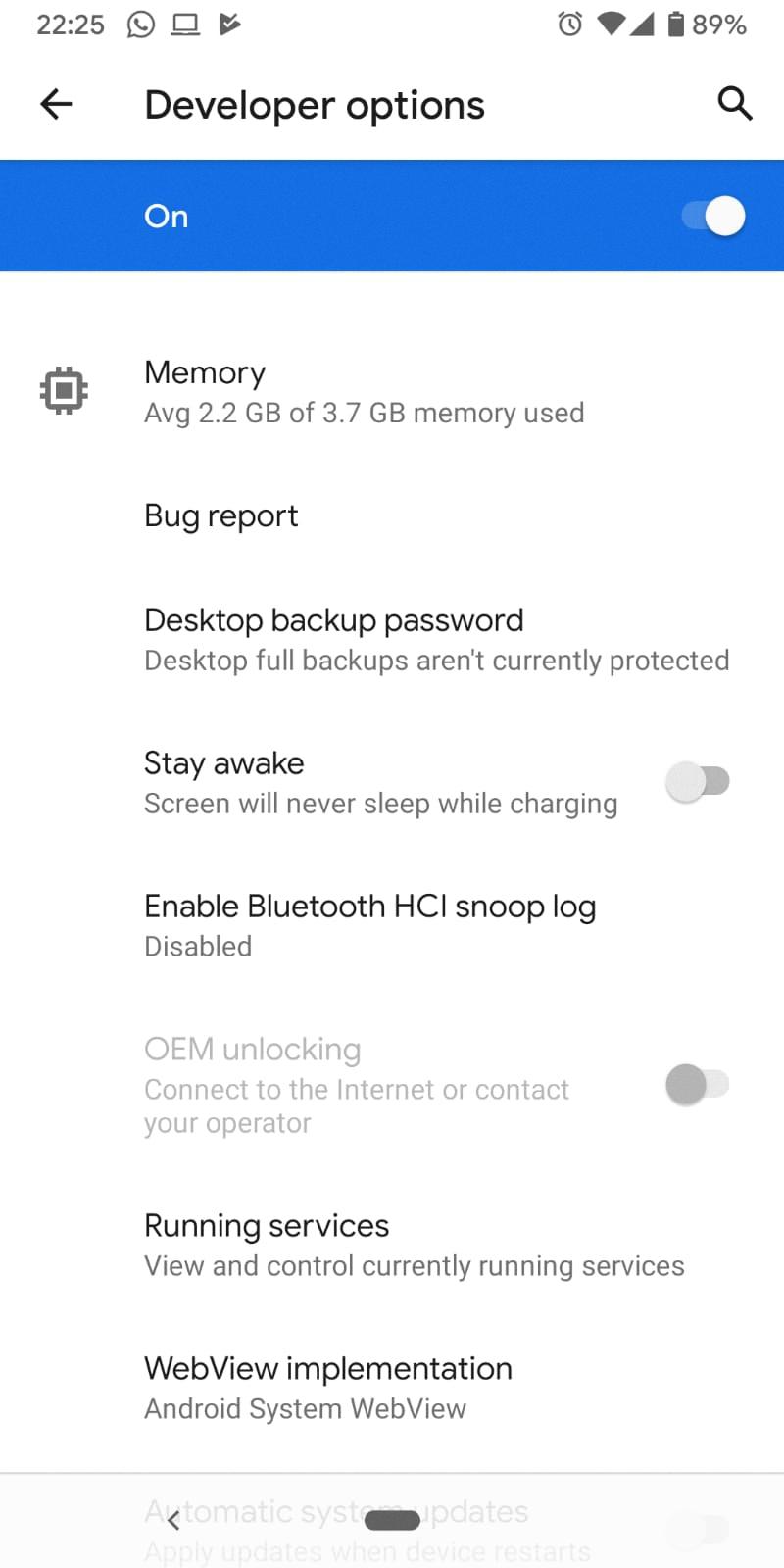Enabling OEM unlock on your Android device can open up a world of possibilities for customization and advanced user control. It is a feature recommended for experienced users who understand the risks involved and are seeking greater flexibility in their device’s operating system.
To enable OEM unlock, you need to access the Developer Options on your device. This can be done by going to Settings, tapping on About Phone, and then tapping on the Build Number repeatedly (usually around seven times) until a message appears confirming that you are now a developer. Once this is done, you can access the Developer Options in the main Settings menu.
Now, what exactly is OEM unlock? OEM stands for Original Equipment Manufacturer, which refers to companies or individuals who manufacture their own phones in their own factories. Some popular Android OEMs include Samsung, LG, and NUU Mobile. By enabling OEM unlock, you are essentially allowing the device’s bootloader to be unlocked, which is the security feature that enables secure boot.
Unlocking the bootloader is a significant step in customizing your device. It allows you to install custom firmware, which can enhance performance, provide additional features, or simply offer a different user experience. This process is often used by Android enthusiasts, developers, and power users who want to take their device customization to the next level.
It is important to note that enabling OEM unlock does come with some risks. Unlocking the bootloader can potentially void your device’s warranty, and it can also leave your device more vulnerable to security threats if not done properly. It is crucial to thoroughly research and understand the process specific to your device before proceeding.
Enabling OEM unlock on your Android device allows for advanced customization and the ability to unlock the bootloader. It is a feature that is best suited for experienced users who are willing to take on the risks involved and have a good understanding of the process. If you are unsure or unfamiliar with the concept, it is advisable to seek guidance or assistance from knowledgeable sources before proceeding.
What Happens If I Enable OEM Unlocking?
Enabling OEM unlocking on your Android device has several consequences and implications. Here is a detailed explanation of what happens when you enable OEM unlocking:
1. Customization: Enabling OEM unlocking gives you the ability to customize your Android operating system to a greater extent. It allows you to install custom ROMs (Read-Only Memory) and modify system settings that are otherwise restricted.
2. Bootloader Unlock: Enabling OEM unlocking is a prerequisite for unlocking the bootloader on your device. Unlocking the bootloader allows you to gain administrative access and install custom recoveries, kernels, and software modifications.
3. Warranty Void: Enabling OEM unlocking typically voids the warranty provided by the original equipment manufacturer (OEM). This means that if you encounter any hardware or software issues, the OEM may refuse to provide free repairs or replacements.
4. Security Risks: By enabling OEM unlocking, you are potentially exposing your device to security risks. Custom ROMs and modifications may not undergo the same level of security testing as official firmware, making your device more vulnerable to malware or hacking attempts.
5. Compatibility Issues: Custom ROMs and modifications are not guaranteed to be compatible with all devices. Enabling OEM unlocking and installing custom software can lead to instability, performance issues, or even render your device inoperable.
6. Data Loss: Enabling OEM unlocking requires unlocking the bootloader, which often involves wiping all data from your device. This means that you will lose all your apps, settings, and personal files unless you have made a backup.
7. Updates and Support: After enabling OEM unlocking, your device may no longer receive official system updates or support from the OEM. This means you may miss out on new features, bug fixes, and security patches provided by the manufacturer.
It is important to note that enabling OEM unlocking is an advanced operation and should only be undertaken by experienced users who understand the risks involved. If you are unsure or unfamiliar with the process, it is recommended to refrain from enabling OEM unlocking to avoid any potential complications or damage to your device.

Is It Safe To Unlock The OEM?
Unlocking the OEM (Original Equipment Manufacturer) is generally safe and will not cause any direct damage to your device. However, it’s important to understand the implications and potential risks involved before proceeding.
Here are some key points to consider:
1. Warranty: Unlocking the OEM may void your device’s warranty. Manufacturers often consider this modification as a breach of their terms and conditions. So, if your device encounters any hardware or software issues later on, you may be denied free repairs or support.
2. Security Risks: Unlocking the OEM allows you to modify the system files and install custom firmware or root your device. While this can offer more control and customization options, it also exposes you to potential security risks. By unlocking the OEM, you are essentially bypassing certain security measures put in place by the manufacturer or operating system.
3. Stability and Performance: Modifying your device’s software by unlocking the OEM can impact its stability and performance. Custom firmware or poorly optimized modifications may cause system crashes, freezes, or slower operation. It’s crucial to research and choose reputable custom ROMs or modifications to minimize these risks.
4. Compatibility Issues: After unlocking the OEM, some apps or features may not work as intended. Certain apps, particularly those with security measures, may detect the modified software and refuse to run. Additionally, future software updates from the manufacturer may not be compatible with custom firmware, resulting in potential compatibility issues.
5. Data Loss: During the process of unlocking the OEM, it’s important to note that there is a risk of data loss. This could include the loss of personal files, settings, or even the entire device becoming bricked (rendered unusable).
To sum up, unlocking the OEM can provide more freedom and customization options for advanced users. However, it comes with potential risks, such as voiding the warranty, security vulnerabilities, stability issues, compatibility problems, and the possibility of data loss. It is important to carefully weigh these risks against the benefits and ensure you have a good understanding of the process before proceeding.
What Is The Benefit Of Unlocking Bootloader?
Unlocking the bootloader of a device can provide several benefits, including:
1. Customization: By unlocking the bootloader, you gain the ability to install custom firmware, also known as custom ROMs, on your device. This allows you to personalize your device’s appearance, features, and performance according to your preferences.
2. Root Access: Unlocking the bootloader often enables you to gain root access to your device. Root access gives you administrative control over your device’s operating system, allowing you to make changes at a system level. With root access, you can remove bloatware, install powerful apps that require root permissions, and tweak system settings for improved performance.
3. Software Updates: Unlocking the bootloader can provide you with faster access to software updates. Manufacturers sometimes delay or stop providing official updates for older devices, but by unlocking the bootloader, you can install custom ROMs that are based on the latest Android versions. This ensures that you can enjoy new features and security patches even if your device is no longer officially supported.
4. Backup and Restore: Bootloader unlocking allows you to create complete backups of your device’s system partitions. In case something goes wrong with your device or you want to revert to the stock firmware, you can easily restore the backup without losing any data. This provides an extra layer of security and flexibility.
5. Advanced Tweaks: Unlocking the bootloader opens up possibilities for advanced tweaks and modifications. You can overclock or underclock your device’s CPU for better performance or battery life, install custom kernels for enhanced stability, and even enable new features that are not available in the stock firmware.
6. Development and Testing: If you are a developer or a tech enthusiast, unlocking the bootloader gives you the freedom to experiment with different software configurations and test your own customizations. This can be particularly useful for app development, system optimization, or exploring new possibilities with your device.
It’s important to note that unlocking the bootloader voids the warranty of your device, and there are potential risks involved, such as bricking your device if not done correctly. Therefore, it is crucial to follow proper instructions and research thoroughly before proceeding with bootloader unlocking.
What Is OEM On Android?
OEM, which stands for Original Equipment Manufacturer, is a term commonly used in the mobile industry, specifically in relation to Android devices. In the context of Android, an OEM refers to companies or individuals who manufacture their own smartphones or tablets in their own factories.
Android is an open-source operating system developed by Google, which allows OEMs to customize and modify the software according to their preferences and requirements. This means that each OEM can create a unique user experience and add their own features and functionalities to the Android devices they produce.
OEMs play a crucial role in the Android ecosystem as they are responsible for designing, manufacturing, and distributing the hardware and software of their devices. They are the ones who decide on the specifications, design elements, and overall look and feel of the Android devices they produce.
Some well-known Android OEMs include Samsung, LG, HTC, Motorola, and Sony. These companies have their own manufacturing facilities where they produce their devices, ensuring that they have full control over the entire production process.
One advantage of having multiple OEMs in the Android ecosystem is the wide variety of device options available to consumers. Each OEM offers its own range of devices with different features, designs, and price points, catering to different consumer preferences.
It is important to note that while OEMs have the freedom to customize the Android software, they still need to comply with certain guidelines set by Google to ensure a consistent user experience and maintain compatibility with the Android ecosystem. This helps ensure that apps and services developed for Android work seamlessly across different devices.
OEM on Android refers to companies or individuals who manufacture their own smartphones or tablets and customize the Android software based on their own preferences and requirements. They play a vital role in the Android ecosystem by offering a diverse range of devices to consumers.
Conclusion
OEM unlock refers to the process of enabling the option to customize the Android operating system and eventually unlock the bootloader on your smartphone. This feature is typically recommended for advanced users who understand the implications and want to have more control over their device. Enabling OEM unlock does not, in itself, cause any damage to your phone. By enabling this option, you can access the hidden Developer Options menu and make advanced customizations to your device. Bootloader unlocking, which is made possible through OEM unlock, allows you to disable the bootloader security and install custom firmware. It is important to note that OEM refers to original equipment manufacturers, which are companies or individuals who manufacture their own phones. Some examples of Android OEMs include Samsung, LG, and NUU Mobile. enabling OEM unlock can provide more flexibility and customization options for your smartphone, but it should be approached with caution and knowledge of the potential risks involved.








